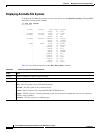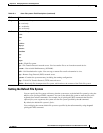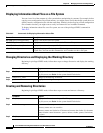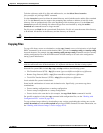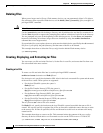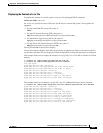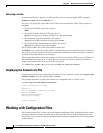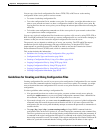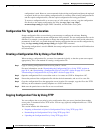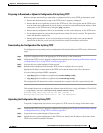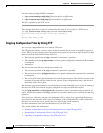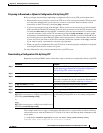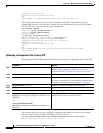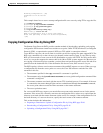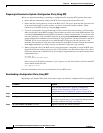
20-9
Cisco IOS Software Configuration Guide for Cisco Aironet Access Points
OL-30644-01
Chapter 20 Managing Firmware and Configurations
Working with Configuration Files
You can copy (download) configuration files from a TFTP, FTP, or RCP server to the running
configuration of the access point for various reasons:
• To restore a backed-up configuration file.
• To use the configuration file for another access point. For example, you might add another access
point to your network and want it to have a configuration similar to the original access point. By
copying the file to the new access point, you can change the relevant parts rather than recreating the
whole file.
• To load the same configuration commands on all the access points in your network so that all the
access points have similar configurations.
You can copy (upload) configuration files from the access point to a file server by using TFTP, FTP, or
RCP. You might perform this task to back up a current configuration file to a server before changing its
contents so that you can later restore the original configuration file from the server.
The protocol you use depends on which type of server you are using. The FTP and RCP transport
mechanisms provide faster performance and more reliable delivery of data than TFTP. These
improvements are possible because FTP and RCP are built on and use the Transmission Control
Protocol/Internet Protocol (TCP/IP) stack, which is connection oriented.
This section includes this information:
• Guidelines for Creating and Using Configuration Files, page 20-9
• Configuration File Types and Location, page 20-10
• Creating a Configuration File by Using a Text Editor, page 20-10
• Copying Configuration Files by Using TFTP, page 20-10
• Copying Configuration Files by Using FTP, page 20-12
• Copying Configuration Files by Using RCP, page 20-15
• Clearing Configuration Information, page 20-18
Guidelines for Creating and Using Configuration Files
Creating configuration files can aid in your access point configuration. Configuration files can contain
some or all of the commands needed to configure one or more access points. For example, you might
want to download the same configuration file to several access points that have the same hardware
configuration.
Use these guidelines when creating a configuration file:
• If no passwords have been set on the access point, you must set them on each access point by
entering the enable secret secret-password global configuration command. Enter a blank line for
this command. The password is saved in the configuration file as clear text.
• If passwords already exist, you cannot enter the enable secret secret-password global configuration
command in the file because the password verification will fail. If you enter a password in the
configuration file, the access point mistakenly attempts to execute the passwords as commands as it
executes the file.
• The copy {ftp: | rcp: | tftp:} system:running-config privileged EXEC command loads the
configuration files on the access point as if you were entering the commands at the command line.
The access point does not erase the existing running configuration before adding the commands. If
a command in the copied configuration file replaces a command in the existing configuration file,
the existing command is erased. For example, if the copied configuration file contains a different IP
address in a particular command than the existing configuration, the IP address in the copied




